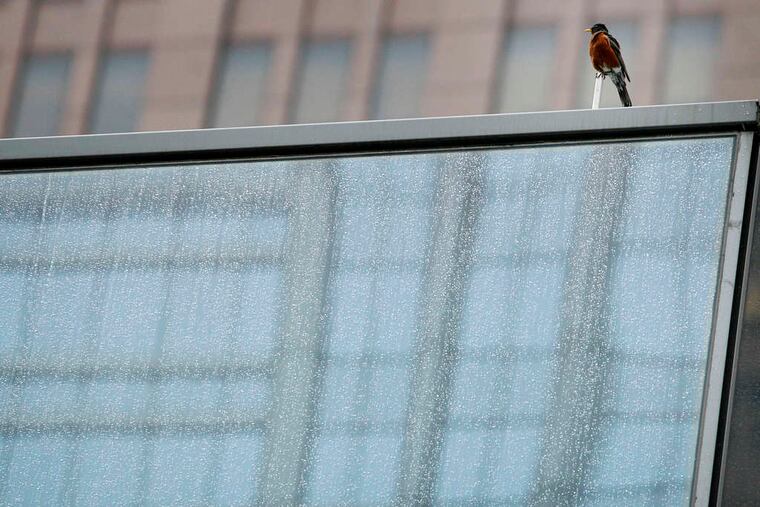Noticing a lot of dead birds around your neighborhood? Here’s why.
Before you let your imagination wander, the answer has nothing to do with the coronavirus.

If you’ve been noticing a lot of dead birds around where you live, you’re not alone.
The topic has been popping up in neighborhood Facebook groups, from those targeting South Philly to Center City to West Philly to the citywide Being Neighborly: Philadelphia group.
“My friend and I talk about this ALL THE TIME! I step over multiple each day,” wrote one poster in Being Neighborly: Philadelphia.
Inquirer readers are spotting them, too. One wrote to us through our Curious Philly portal to ask: “I have been noticing lots of dead adult birds on the ground in the Old City / Society Hill area while walking my dog. My friends in Northern Liberties are noticing this as well … Any idea why?”
Before you let your imagination wander, the answer has nothing to do with the coronavirus, says Jason D. Weckstein, Ph.D. an associate curator of ornithology at the Academy of Natural Sciences of Drexel University and Drexel University professor. Although, the pandemic could be to blame for why you’re noticing the unfortunate phenomenon.
“The whole COVID crisis has forced people to live in the moment in many ways,” says Weckstein. “Now, people aren’t rushing anywhere anymore. They’re getting out and noticing nature more, and all of the creatures around them.”
Dead birds, both babies and adults, are a normal part of the urban environment, says Weckstein. And spring is high season for bird deaths, for two main reasons.
Dead baby birds
First, it’s breeding season right now for many of the common bird species in the city.
“What you are probably seeing most are baby birds that have fallen out of their nests,” says Weckstein. “These are likely mostly baby European starlings, house sparrows, and rock pigeons. Some of them could be American robins.”
Hatchlings (up to 3 days old) and nestlings (3 to 13 days old) — both too young to leave the nest — can fall for a variety of reasons. Most of it is by accident, the result of a flimsy nest or an attempt to take flight before it’s time. Sometimes predators will scare them and trigger a premature hop.
For fledglings, fully feathered birds that are ready to jump or start fluttering their wings, casualties are a common part of the process of leaving the nest.
“If you’re a fledgling, your parents will stick with you, but there are a lot of predators in the city,” says Weckstein, “If you hop out [of the nest], and you’re not in a sheltered spot where you can hide while waiting for mom or dad to feed you, you can get eaten.”
One of the biggest enemies: cats. Cats kill between 1.3 billion and 4 billion birds a year, according to a report published in the science journal Nature Communications. And in the region, where there are around 400,000 feral and free-roaming cats, there’s no lack of furry paws and sharp claws for birds to dodge.
» READ MORE: Philly has 400,000 stray cats. Here’s how to deal with it.
“Some predators will eat the birds, like hawks, but cats will just kill them and leave them there,” says Weckstein. “It’s hard being a baby bird — there’s a lot of mortality.”
It’s true. Most baby songbirds leave the nest before they can fully fly, and according to Mass Audubon, only 30% survive their first year of life.
But young fledglings are also quite resilient. When they take that first jump out of the nest, yes, sometimes they get injured, says Weckstein, but they’re pretty good at bouncing back on their feet. Far over on the Arctic coast, Barnacle goose babies begin their lives by plunging off cliffs as high as 400 feet tall.
Adult deaths
It’s not just little ones that are dying. Adult bird deaths are also common in the spring.
“We see it every year in the spring and the fall because we have this epic migration of birds, some flying as far as from South America to Canada's boreal forest,” says Weckstein. “Unfortunately in the city, we have these tall glass buildings, and the birds are hitting them, especially when they’re lit up.”
Migration ends in the beginning of June, so plenty of additional birds are still flying through Philadelphia at the moment. The majority of birds navigate at night, using the stars as guides. They’re attracted to the lit up buildings, especially at dawn, which can result in fatal collisions. And although many people in those tall offices are currently working from home, most remain lit 24 hours.
Deaths happen during the daytime, too. If birds see a reflection of a tree on the glass, they’ll fly right toward it. And like babies, adults have to contend with predators like cats.
These are all among the reasons why you might find a dead bird lying on the sidewalk. Again, it’s nothing unusual, especially during this time of year.
“As far as I am aware there isn’t any special increase in the number of dead birds being seen these days, and it’s definitely not something special about COVID,” says Weckstein. “What is special — seeing how many people are out enjoying the outdoors. It’s maybe one of the positive things that has come out of all of this.”